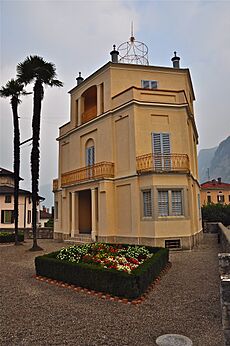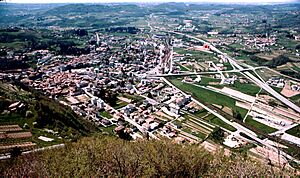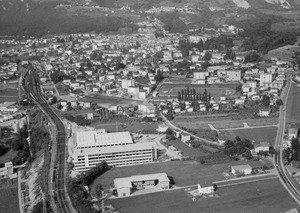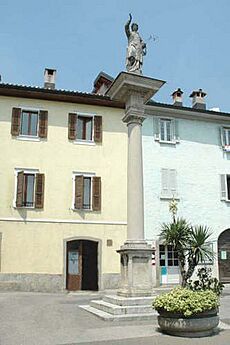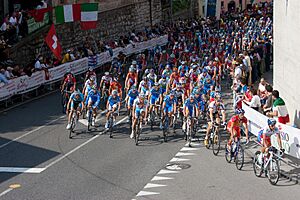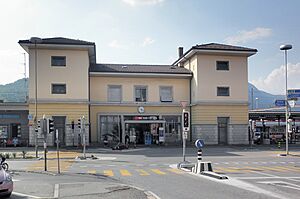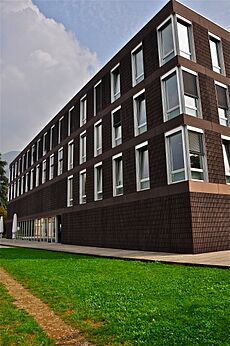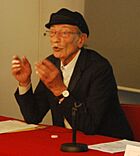Mendrisio facts for kids
Quick facts for kids
Mendrisio
|
||
|---|---|---|
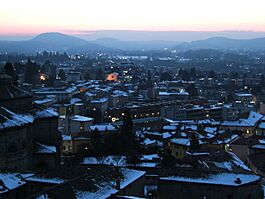
Mendrisio during the winter
|
||
|
||
| Country | Switzerland | |
| Canton | Ticino | |
| District | Mendrisio | |
| Area | ||
| • Total | 31.77 km2 (12.27 sq mi) | |
| Elevation | 354 m (1,161 ft) | |
| Population
(Dec 2020 )
|
||
| • Total | 14,902 | |
| • Density | 469.06/km2 (1,214.86/sq mi) | |
| Postal code |
6850
|
|
| Localities | Arzo, Capolago, Genestrerio, Rancate, Salorino, Tremona, Besazio, Ligornetto, Meride | |
| Surrounded by | Castel San Pietro, Coldrerio, Genestrerio, Novazzano, Melano, Riva San Vitale | |
Mendrisio is a town in the Ticino region of Switzerland. It's a special place because it's home to the Academy of Architecture. This is part of the university for Italian-speaking Switzerland.
Over the years, Mendrisio has grown bigger. It has joined with several nearby villages. For example, Salorino joined in 2004. Then, in 2009, Arzo, Capolago, Genestrerio, Rancate, and Tremona became part of Mendrisio. Finally, in 2013, Besazio, Ligornetto, and Meride also merged with the town.
Mendrisio is easy to reach by train. It has two train stations: Mendrisio railway station and Mendrisio San Martino railway station.
Contents
History of Mendrisio
Mendrisio was first mentioned in records way back in the year 793. It was known as Mendrici then. People also used to call it Mendris in German, but that name isn't used anymore.
Even before 793, people lived here. Archeologists have found about thirty Roman tombs. They also found parts of a Roman villa and old coins. This shows that Romans lived in the area a long time ago.
After the Roman Empire ended, Mendrisio became an important center for the Lombards. It grew into a town during the Middle Ages. People built walls and forts to protect the town. Later, a powerful family called the Torriani built their castle on the hills above Mendrisio.
Mendrisio became an independent town in 1140. It was part of a larger area called the County of Seprio. But then, in 1170, the city of Como took control. Mendrisio stayed under Como's rule until 1335. After that, Milan took over Como, and Mendrisio became part of Milan's lands until 1402.
In the late 1400s and early 1500s, the Swiss Confederation started to expand. By 1512, the Swiss captured Lugano and took over the Mendrisio area. In 1521, the Swiss set up a system to share control over these new lands. They appointed a special officer, called a bailiff, to manage Mendrisio.
Mendrisio remained a conquered territory for a long time. It had limited freedom until 1798. That's when the French invaded Switzerland and created the Helvetic Republic. This changed things for Mendrisio.
Churches and Schools
Mendrisio was part of a larger church area called Balerna until the 1400s. Later, two main churches were built in Mendrisio. These were the churches of SS Cosma e Damiano and S. Sisinio.
The Church of SS Cosma e Damiano was first built in 1672 in the Baroque style. The first building was taken down in the 1800s. A new church was built nearby between 1863 and 1875. It was built in the Classicist style. The church of S. Sisino was built outside the town.
Several religious groups also came to Mendrisio. They included the Humiliati, the Servite Order, the Ursulines, and the Capuchins. The Servites started a boys' school in 1644. This school later became a public secondary school in 1852. In the 1800s, the convents and monasteries of these religious groups became public property.
Growth and Modern Times
In the last century, Mendrisio has grown a lot. It has developed many factories. In the late 1800s, one of the first factories was a spinning mill. It employed about 350 women and children. This was more than 10% of the town's population in 1900!
These factories brought many jobs to Mendrisio. People moved from villages to live in the town. The population doubled in just 60 years during the late 1800s. Rich factory owners built large, fancy houses and a hospital.
The arrival of the railroad also helped the town grow. It brought more people and businesses. In the 1900s, many service companies opened in Mendrisio. The factory industry started to become less important. By 2000, most working people in Mendrisio had jobs in the service industry.
Mendrisio is very close to the Italian border. This means that many people who live or work there travel across the border every day. As a district capital, Mendrisio offers many services to the towns around it. A special clinic for mental health opened in 1898. Primary and secondary schools opened in 1944. In 1996, the School of Architecture of the Università della Svizzera italiana opened its doors.
Geography of Mendrisio
After the villages merged in 2013, Mendrisio covers an area of about 30 square kilometers (11.7 square miles).
A good part of Mendrisio's land is covered by forests (27%). About 15% is used for farming. Over 22% of the land has buildings or roads. A small amount is rivers or lakes.
Mendrisio is the main town of the Mendrisio district. It is located on the slopes of a mountain called Monte Generoso. As mentioned, it has grown by joining with several nearby villages over the years.
Mendrisio's Coat of Arms
The coat of arms for Mendrisio is simple and striking. It shows a white cross on a red background.
People of Mendrisio
Mendrisio has a population of about 15,700 people (as of 2022). About 23.5% of the people living in Mendrisio are from other countries.
Most people in Mendrisio speak Italian. About 87.5% of the population speaks Italian. The next most common language is German (4.8%), followed by French (1.4%).
The population of Mendrisio has changed over time. You can see how the number of people has grown in the chart below:

Important Heritage Sites
Mendrisio is home to many important heritage sites. These are places that are very important to Switzerland's history and culture.
Some of these sites include:
- Three churches: S. Sisinio alla Torre, S. Martino, and the S. Giovanni complex (which has a convent, the Church of S. Giovanni, and the Oratory of S. Maria).
- Six grand houses or palaces: Croci House, Dei Pagani Tre Buchi House, Palazzo Pollini, Palazzo Torriani, Villa Argentina, and the Villa and mosaics of S. Maria in Borgo.
- The Giovanni Züst Art Gallery (Pinacoteca cantonale Giovanni Züst).
- The Tremona archeological site, where old remains have been found.
After the mergers in 2013, two more important sites were added: the Museo Vela from Ligornetto and the Church of S. Silvestro from Meride. The villages of Ligornetto and Meride themselves are also considered important heritage sites.
Things to See in Mendrisio
Mendrisio is sometimes called il magnifico borgo, which means "the magnificent town." This is because it has many beautiful old buildings. For a long time, the town has been a leader in using electric cars. The areas around Mendrisio are also famous for growing wine grapes in Canton Ticino.
The town is also known for its special Good Friday procession. This event is so important that UNESCO added it to its list of intangible world heritage in 2019. During the procession, people act out the story of Christ's passion in a peaceful way. Mendrisio also celebrates a fun grape festival called Sagra dell'uva in late September.
Sports in Mendrisio
Mendrisio has a football (soccer) team called FC Mendrisio-Stabio. They play in the Swiss 1st League.
The town is also famous for cycling. It hosted the 1971 UCI Road World Championships on September 4, 1971. It also hosted the 2009 UCI Road World Championships from September 23 to 27, 2009. A famous cyclist named Cadel Evans, who lives in the Mendrisio area, won the gold medal in the men's race that year!
Mendrisio's Economy
In Mendrisio, people work in different types of jobs. Some work in the primary sector, which means farming. Others work in the secondary sector, like in factories. Many people work in the tertiary sector, which includes services like shops, hotels, and healthcare.
In 2008, there were over 9,000 full-time jobs in Mendrisio. Most of these jobs were in manufacturing (making things) and services. Many people work in sales, transportation, hotels, or restaurants. There are also jobs in finance, science, education, and healthcare.
Mendrisio is a place where many people come to work. In 2000, over 10,000 workers traveled into the town for their jobs. About 33% of these workers came from outside Switzerland, especially from Italy. This is because Mendrisio is very close to the Italian border. Most people get to work by private car.
Mendrisio is home to Vinattieri Ticinesi, which is the largest winemaker in Switzerland. They produce a type of wine called merlot. The company Metaltex, which makes household goods, also has its main office in Mendrisio. There are also four gold refining factories in the town. These factories make refined gold, which is used to create watches and jewellery.
Religion in Mendrisio
According to the 2000 census, most people in Mendrisio are Roman Catholic (81.1%). A smaller number belong to the Swiss Reformed Church (4.5%). Some people belong to other churches, and a few did not state their religion.
Education in Mendrisio
In Mendrisio, many adults have completed higher education. About 65% of people aged 25–64 have finished high school or gone on to university or a specialized college.
The education system in Ticino, where Mendrisio is located, offers different levels of schooling:
- Kindergarten: Children can attend up to three years of non-mandatory kindergarten.
- Primary School: This program lasts five years.
- Lower Secondary School: Students can choose between a two-year middle school followed by a pre-apprenticeship, or a four-year program to prepare for higher education.
- Upper Secondary School: This level prepares students for trades or for university. Students can do vocational training while working or attend school full-time.
- Professional Program: This three-year program prepares students for jobs in fields like engineering, nursing, computer science, or tourism.
Many students come to Mendrisio from other towns for school. In 2000, over 1,000 students came from outside Mendrisio to attend schools there.
Mendrisio also has a library for the Università della Svizzera Italiana. In 2008, this library had over 141,000 books and other media.
Since 2021, Mendrisio is also home to a department of the Scuola Universitaria Professionale della Svizzera Italiana (SUPSI). This school focuses on environment, construction, and design.
Transportation in Mendrisio
Mendrisio has two train stations: Mendrisio railway station and Mendrisio San Martino railway station. Both stations are on the Gotthard line. Trains run regularly from Mendrisio to places like Milano Centrale, Malpensa Aeroporto Terminal 2, Varese, Bellinzona, Erstfeld, and Como San Giovanni. The Mendrisio San Martino station was built to be close to the industrial areas and shopping centers.
Famous People from Mendrisio
Many talented people have come from Mendrisio or have strong connections to the town:
- Józef Fontana (1676–1739), an architect who moved to Poland.
- Giulio Guglielmetti (1901–1987), who was the mayor of Mendrisio for many years.
- Luigi Snozzi (born 1932), a Swiss architect.
- Bruno Monguzzi (born 1941), a Swiss graphic designer.
- Peter Zumthor (born 1943), a famous architect and professor at the Accademia di Architettura di Mendrisio. He won the Pritzker Architecture Prize in 2009.
- Mario Botta (born 1943), an architect and professor at the Accademia di Architettura di Mendrisio.
- Fabio Pusterla (born 1957), a Swiss translator and writer.
- Mauro Urbano (born 1968), a writer and art collector.
- Paolo Meneguzzi (born 1976), a Swiss-Italian singer.
- Sports Stars
- Clay Regazzoni (1939–2006), a Swiss racing driver who competed in Formula One. He won five Grand Prix races.
- Rocco Travella (born 1967), a cyclist who competed in the Olympics.
- Patrick Foletti (born 1974), a former Swiss goalkeeper, now a coach for the Swiss national football team.
- Michael Rogers (born 1979), a retired Australian professional road bicycle racer who lives in Mendrisio.
- Michael Albasini (born 1980), a Swiss professional road bicycle racer.
- Fulvio Sulmoni (born 1986), a Swiss footballer.
- Roberto Kovac (born 1990), a Swiss professional basketball player.
- Alessandro Martinelli (born 1993), a Swiss professional footballer.
See also
 In Spanish: Mendrisio para niños
In Spanish: Mendrisio para niños






